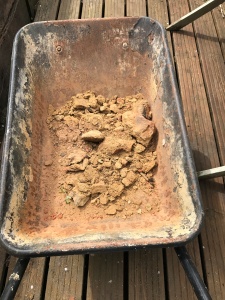Hey, oven lovers! This is a tiny little post to show you that the clay:sand mixture we use to build these super ovens can be recycled (or rejuvenated).
As you will see, if you read my previous post, I had to do some pretty major repairs to my oven recently. Anyone who has gone to the effort of building one of these ovens will tell you that the most tedious part of the whole process is puddling the clay:sand mixture. It is hard work and very boring so, while you are going to the bother of doing it, I recommend mixing a little more than you need and storing the extra in plastic sacks. You will use it for filling cracks and maybe, one day, to undertake more major repair work. You might also need to partially, or even wholly, remove one of the dry layers, particularly if you abuse your oven as much as I have mine. Well don’t throw that dry stuff away, and if your bagged material is dry, make sure you keep that too.
All you need to do is add some water to it, leave it for a while and, hey presto, it’s as good as new. Sweet!!
- Dry (sad face)
- Wet (happy face)


Just found this site – great reading. Just completed a clay oven built using a guide in the River Cottage bread book. Everything seemed to go according to plan but the inside layer is rapidly disintegrating with the fires. I also noticed the other two layers are disintegrating rapidly along the chimney.
Seems like the layers are unable to stand the heat.
Any thoughts why this might be happening? I wondered whether the clay was not suitable. I sourced it from beside a turlough (temporary lake).
Thanks for any advice.
Cormac
You do need to keep patching these ovens but the internal oven layer is hard to do. Did you use a good mixture of clay and sand?
Thanks for the response. Turns out the sand I used wasn’t fine enough. Rebuilt it and all is good.
HI I have a question. I’m rebuilding my oven, and actually creating a proper base to build upon. The last time I built my oven, I really used my imagination when dealing with the insulation layer. I used pine cones (not the big fat kind), needles, grass etc. Since I’m going to rebuild, should i try to remove all of this as much as I can? I’m thinking that some of that stuff, especially the pine cones, may have contributed to some of the cracking that i experienced?
Thanks
Peter M
I can’t say for sure but I wouldn’t think so. These ovens do crack – they expand significantly when heated and that expansion can only be accommodated by cracking. Having said that, if the material you used for insulation consisted significant amounts of violations (water, etc.) the that could lead to pronounced cracking due to degassing.
Good old wood shavings and clay slip work just right in my experience.
S
Reblogged this on OBs World.
I had to rebuild my oven completely this spring since I had used thin saltillo tiles for the floor of the oven (bad idea) instead of proper hearth bricks. Luckily, as described in this post, I was able to reuse the outer, sculptural cob, and the insulating layer (slip and pearlite). The innermost thermal layer had converted to a brittle terra cotta ceramic. I ground it into a grog for primative terra cotta pots made from the same mud I used for my oven.